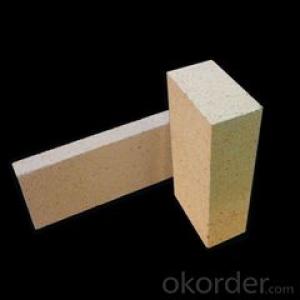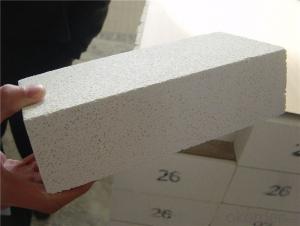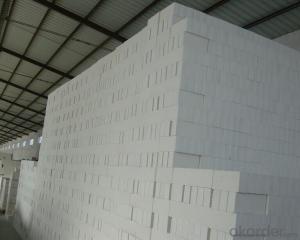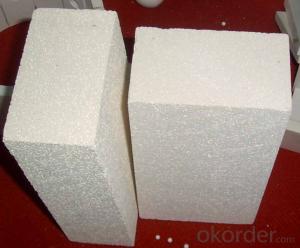Insulating Fire Brick - Refractory Mullite Insulating Refractory Brick JM 39
- Loading Port:
- Shanghai
- Payment Terms:
- TT OR LC
- Min Order Qty:
- 20 m.t.
- Supply Capability:
- 20 m.t./month
OKorder Service Pledge
OKorder Financial Service
You Might Also Like
Okorder series heat insulation brick
Okorder series thermal insulation brick is an effective, energy saving, low carbon, environmental protection advanced, according to the ASTM standard manufacturing products. Okorder series products have all kinds of materials in the field of metallurgy, industrial furnaces, aluminum, the best Li Ning petrochemical and insulation, electric power and glass ceramics. They can be used as part of an insulation or not to melt. Products have been widely used in the following furnace, achieved satisfactory results.
Application of heat preservation brick
Metallurgical Industry: blast furnace, hot blast furnace, heating furnace, etc..
Petrochemical Industry: ethylene cracking furnace, hydrogen furnace, the main furnace, heating furnace, etc..
Ceramic industry: roller kiln, kiln, etc..
Glass industry: glass furnace regenerator, etc.
Carbon industry: carbon furnace, etc..
Aluminum electrolysis industry: aluminum reduction cell, etc.
Other industries: tunnel kiln, shuttle kiln, etc..
Advantages of heat insulation brick
Low thermal conductivity: many air holes will bring good thermal insulation effect, energy saving.
High crushing strength: high crushing strength, volume stability.
Low heat storage: small heat storage, absorb more heat, energy-saving effect is obvious.
Chundu: High-speed Rail, low content of alkali metal impurities.
Accuracy: the size of the brick machining precision, cutting and grinding the special shape, speed up the brick.
Insulating brick


- Q: What are the different types of insulating fire bricks available in the market?
- In the market, one can find a variety of insulating fire bricks. Some of the frequently encountered types are as follows: 1. Lightweight Fire Bricks: These bricks are crafted from lightweight and porous materials like expanded clay, vermiculite, or perlite. They possess exceptional insulation properties and are commonly utilized in scenarios where weight is a critical factor, such as lining kiln or furnace walls. 2. Ceramic Fiber Bricks: These bricks are formed by compressing and shaping ceramic fibers. They exhibit high insulation properties, low thermal conductivity, and can withstand high temperatures. Ceramic fiber bricks are frequently employed in applications that demand insulation in high-temperature environments, such as constructing industrial furnaces or ovens. 3. Calcium Silicate Bricks: These bricks are produced from a combination of lime, silica, and reinforcing fibers. They possess favorable thermal insulation properties and are resistant to thermal shock. Calcium silicate bricks are commonly employed in situations where high-temperature insulation is necessary, such as building boilers or incinerators. 4. Magnesia Bricks: These bricks are composed of highly refractory magnesium oxide. They possess excellent thermal insulation properties and can endure extremely high temperatures. Magnesia bricks are often used in environments requiring insulation at high temperatures, such as lining steel-making furnaces or glass melting tanks. 5. Vermiculite Bricks: These bricks are made from naturally occurring expanded vermiculite. They exhibit good insulation properties, low thermal conductivity, and resistance to high temperatures. Vermiculite bricks are commonly used in applications that necessitate lightweight insulation, such as constructing chimneys or fireplace surrounds. In conclusion, the selection of insulating fire bricks depends on specific requirements like desired insulation level, temperature resistance, and weight considerations for the particular application.
- Q: Can insulating fire bricks be used in foundries?
- Yes, insulating fire bricks can be used in foundries. They are commonly used as lining materials for various high-temperature applications, including foundries. Insulating fire bricks provide excellent thermal insulation, reducing heat loss and improving energy efficiency in the foundry process. Additionally, they have good resistance to thermal shock and can withstand the extreme temperatures and harsh conditions often found in foundry environments.
- Q: How to do indoor thermal insulation
- Soft packing can also achieve warmth effectTry to change the interior decoration style, whether in visual or make new home warm, in all senses such as the fabric furniture instead of wood or iron rattan furniture, or the use of fabric material packaging wood seat, living room, bedroom stone and tile carpet, lighting equipment can be replaced with warm light lamp. Wall hanging tapestry. When choosing curtain, choose the curtain with thick cloth, thick, insulated and warm effect as much as possible. In addition, the cold tone leather sofa "cotton": a soft warm cotton sofa is the inevitable choice, also can make full use of cotton cushion and pillow.
- Q: Do insulating fire bricks have good insulation performance at high temperatures?
- Insulating fire bricks possess remarkable insulation capabilities when exposed to elevated temperatures. These bricks are meticulously crafted to endure exceedingly high temperatures and deliver exceptional thermal insulation. Constructed from lightweight materials with minimal thermal conductivity, they adeptly confine and retain heat within furnaces, kilns, and similar high-temperature contexts. This insulation attribute aids in minimizing heat dissipation and upholding a steady temperature within the structure. Insulating fire bricks are extensively utilized across various industries including ceramics, metallurgy, glass production, and heat treatment, where the preservation of high temperatures and thermal efficiency is of utmost importance.
- Q: What are the different sizes and shapes available for insulating fire bricks?
- Insulating fire bricks come in various sizes and shapes to meet different insulation needs. Common sizes include standard, medium, and large, with dimensions ranging from 9" x 4.5" x 2.5" to 12" x 12" x 2". As for shapes, they are available in rectangular, square, and custom shapes like arches and wedges. The specific size and shape of the insulating fire brick depend on the requirements of the application and the manufacturer's offerings.
- Q: Are there any safety precautions to consider when using insulating fire bricks?
- Yes, there are safety precautions to consider when using insulating fire bricks. Firstly, it is important to wear appropriate personal protective equipment, such as gloves and safety goggles, to protect against potential injuries. Additionally, due to the high temperatures involved, it is crucial to handle the bricks with care to avoid burns or related accidents. Adequate ventilation should be ensured to prevent the buildup of harmful gases and fumes. Lastly, it is essential to follow the manufacturer's instructions and guidelines for proper installation and usage to minimize any potential risks.
- Q: Can insulating fire bricks be used in ladle covers?
- Insulating fire bricks can indeed be used in ladle covers. These bricks are specially designed to have low thermal conductivity, which means they can effectively insulate and retain heat. Ladle covers are used in foundries and other high-temperature industries to keep molten metal or other materials hot and prevent heat loss. By using insulating fire bricks in ladle covers, the heat is better retained, resulting in improved energy efficiency and reduced fuel consumption. Additionally, these bricks have high refractory properties, allowing them to withstand the extreme temperatures and thermal shock that ladles are subjected to. Overall, insulating fire bricks are an excellent choice for ladle covers, as they help to maintain temperature stability and conserve heat.
- Q: Can insulating fire bricks be used in outdoor applications?
- No, insulating fire bricks are not suitable for outdoor applications as they are not designed to withstand the harsh environmental conditions typically found in outdoor settings.
- Q: Can insulating fire bricks be used as a lining for kiln cars?
- Indeed, insulating fire bricks exhibit remarkable thermal insulation qualities, rendering them appropriate for utilization as linings in kiln cars. These bricks are specifically engineered to withstand elevated temperatures without experiencing any fractures or disintegration, thereby establishing them as an optimal option for securing kiln cars. Furthermore, their lightweight composition facilitates convenient handling and installation, thereby diminishing the overall weight and energy consumption of the kiln. Consequently, insulating fire bricks effectively supply insulation and safeguard kiln cars, significantly enhancing their efficiency and longevity.
- Q: Outside brick wall, inside brick wall how to return a responsibility?
- In general, the wall of the building and outdoor harsh environment, so the general exterior wall tiles with full ceramic tile surface, then is the kind of uneven, and the appearance of the size deviation of brick is relatively large.
Send your message to us
Insulating Fire Brick - Refractory Mullite Insulating Refractory Brick JM 39
- Loading Port:
- Shanghai
- Payment Terms:
- TT OR LC
- Min Order Qty:
- 20 m.t.
- Supply Capability:
- 20 m.t./month
OKorder Service Pledge
OKorder Financial Service
Similar products
Hot products
Hot Searches
Related keywords




























